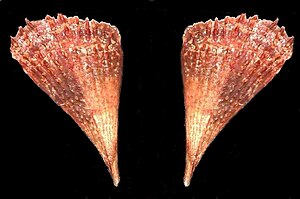Pinna carnea
| Pinna carnea | ||||||||||||
|---|---|---|---|---|---|---|---|---|---|---|---|---|

|
||||||||||||
| Systematics | ||||||||||||
|
||||||||||||
| Scientific name | ||||||||||||
| Pinna carnea | ||||||||||||
| Gmelin , 1791 |
The Pinna carnea is a type of mussel from the pen mussel family (Pinnidae). The species is native to the Gulf of Mexico , the Caribbean and the coast of Brazil .
features
The case , which is triangular in outline , is up to 39.5 cm long. The very small, inconspicuous vertebrae sit at the front end. The ventral edge initially runs straight from the front end and is then curved convexly towards the rear end. The dorsal margin is straight to slightly concave. The posterior margin is slightly arched with rounded transitions to the ventral and dorsal margin. It can be almost perpendicular to the longitudinal axis, but it can also be sloping towards the ventral edge. There are two sphincters. The anterior sphincter is small and elongated, and sits immediately on the anterior end. The posterior sphincter is medium-sized and ovoid in cross-section; it sits on the posterior edge of the dorsal tongue of the mother-of-pearl layer. The dorsal layer of mother-of-pearl is shorter than the ventral layer of mother-of-pearl. The sulcus between the dorsal and ventral tongue of the mother-of-pearl layer is narrow, tapering to a point and only reaches about a third into the mother-of-pearl layer. The mother-of-pearl layer only takes up the front third of the case.
The shell of juvenile specimens is very thin-walled and fragile. They are translucent and horn-brown to reddish brown in color. Adult shells are deep red, and the surface or the ribs are usually rougher (but this depends on the habitat). The surface is carved with eight to twelve radial ribs, into which finer ribs interpose during growth. Usually the ribs are not thorny, but more often they are knotty and thickened. Single tubular spines open to the rear are only occasionally present, especially near the rear end. Dry housings gape at the rear end, and when subjected to pressure they become brittle and break. However, during life the housings are still flexible to some extent; the housings can still be completely closed with the help of the sphincter muscles.
Similar Art
Pinna carnea is very similar to the rough ham clam ( Pinna rudis ). In this species, however, the dorsal tongue of the mother-of-pearl layer is as long as or even longer than the ventral tongue. The ham clam has only five to ten radial ribs with strong spines at wide, irregular intervals, whereas the Pinna carnea has eight to twelve fine radial ribs with finer ribs in between. A characteristic feature of the ham clam, however, are large, tubular spines open towards the rear end at irregular intervals on the ribs. In Pinna carnea there are a few, small spines that are limited to the dorsal part of the housing.
Geographical distribution and habitat
The range of Pinna carnea is the Gulf of Mexico and the Caribbean as well as the waters around the Bahamas. In the south, the distribution extends to the Brazilian state of Espírito Santo .
The animals are stuck with the front end about half vertically in the sediment of protected areas. They prefer sediments of fine coral sand and sandy-silty soils, often in seagrass meadows from the tidal range to about 34 meters water depth. They are attached in the sediment to a rubble or a larger shell with the help of the byssus.
A pair of the shrimp species Pontonia mexicana Guérin-Méneville, 1855 , often lives in the mantle cave of Pinna carnea .
Taxonomy
The taxon was set up in 1791 by Johann Friedrich Gmelin . The species is generally recognized as a valid taxon.
literature
- Peter Schultz, Markus Huber: Revision of the worldwide Recent Pinnidae and some remarks on fossil European Pinnidae. Acta Conchyliorum, 13: 164 S., Hackenheim, ConchBooks, 2013 PDF (summary)
- Charles Maurice Yonge : Form and Habit in Pinna carnea Gmelin. Philosophical Transactions of the Royal Society of London. Series B, Biological Sciences, 237 (648): 335-374, 1953, JSTOR 92484
Individual evidence
- ↑ J. Antonio Baeza, Juan A. Bolaños, Jesús E. Hernandez, Carlos Lira, Régulo López: Monogamy does not last long in Pontonia mexicana, a symbiotic shrimp of the amber pen-shell Pinna carnea from the southeastern Caribbean Sea. Journal of Experimental Marine Biology and Ecology, 407 (1): 41-47, 2011 doi : 10.1016 / j.jembe.2011.07.011
- ^ Johann Friedrich Gmelin: Caroli a Linné, systema naturae. Tom. I. Pars VI. [Editio decima tertia, aucta, reformata]. Pp. 3021–3910, Lipsiae / Leipzig, Beer, 1791 Online at www.biodiversitylibrary.org (p. 3365)
- ↑ MolluscaBase: Pinna carnea Gmelin, 1791